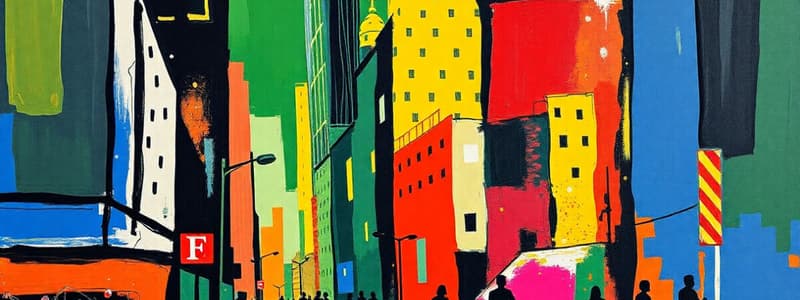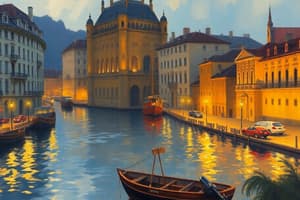Podcast
Questions and Answers
According to the urban economic perspective, how is the city primarily conceived?
According to the urban economic perspective, how is the city primarily conceived?
- A self-regulating market for consumer demand and supply. (correct)
- A political entity defined by administrative boundaries.
- A historical artifact reflecting past civilizations.
- A center for cultural exchange and artistic expression.
In Marxist analysis, what is the primary focus concerning capital?
In Marxist analysis, what is the primary focus concerning capital?
- The role of exchange in creating fair markets.
- The equitable distribution of wealth among all citizens.
- The impact of government regulation on economic stability.
- The accumulation of profit as a driving force. (correct)
According to Marx, what is the relationship between the economic base and the superstructure in society?
According to Marx, what is the relationship between the economic base and the superstructure in society?
- The superstructure directly determines the economic base.
- The superstructure serves to obscure or mystify the economic base. (correct)
- The economic base is independent of the superstructure.
- They are mutually exclusive and have no impact on each other.
What does Marx identify as a major contradiction inherent in capitalism?
What does Marx identify as a major contradiction inherent in capitalism?
According to Harvey, how do cities function in relation to capitalist accumulation?
According to Harvey, how do cities function in relation to capitalist accumulation?
According to Saskia Sassen, what role do global cities play in the global economy?
According to Saskia Sassen, what role do global cities play in the global economy?
How did Benjamin view the arcades in Paris?
How did Benjamin view the arcades in Paris?
What does Benjamin mean by 'phantasmagoria' in the context of Haussmannization?
What does Benjamin mean by 'phantasmagoria' in the context of Haussmannization?
How did Benjamin characterize the experience of boundaries in cities?
How did Benjamin characterize the experience of boundaries in cities?
According to Buck-Morss, what message did world exhibitions convey?
According to Buck-Morss, what message did world exhibitions convey?
What is the significance of Marx contrasting his theories with other later theories?
What is the significance of Marx contrasting his theories with other later theories?
How does the concept of 'surplus-value' relate to Marx's critique of capitalism?
How does the concept of 'surplus-value' relate to Marx's critique of capitalism?
In the context of Marxist analysis, what is meant by 'means of production'?
In the context of Marxist analysis, what is meant by 'means of production'?
What is the significance of the phrase 'cities are the nodes'?
What is the significance of the phrase 'cities are the nodes'?
According to the passage, what is one of the main functions of major cities regarding crises of accumulation?
According to the passage, what is one of the main functions of major cities regarding crises of accumulation?
What is the relationship between knowledge production and the knowledge economy according to the passage?
What is the relationship between knowledge production and the knowledge economy according to the passage?
According to Myung-Rae Cho, how is economic restructuring achieved in rapidly industrializing Asian cities?
According to Myung-Rae Cho, how is economic restructuring achieved in rapidly industrializing Asian cities?
What does Sassen mean by 'the annihilation of space'?
What does Sassen mean by 'the annihilation of space'?
How are women’s work and bodies typically represented in the economic analysis of cities?
How are women’s work and bodies typically represented in the economic analysis of cities?
According to Benjamin what is the purpose of the enobling of technological necessities?
According to Benjamin what is the purpose of the enobling of technological necessities?
In what ways does Benjamin believe that world exhibitions obscure class antagonisms.
In what ways does Benjamin believe that world exhibitions obscure class antagonisms.
In Marx's view of history as class struggle, what is the significance of 'contradiction'?
In Marx's view of history as class struggle, what is the significance of 'contradiction'?
How does Marx's concept of 'commodity fetishism' apply to urban studies?
How does Marx's concept of 'commodity fetishism' apply to urban studies?
According to the reading, what characterizes global cities in the contemporary economy?
According to the reading, what characterizes global cities in the contemporary economy?
How does Benjamin describe the urban experience in the arcades?
How does Benjamin describe the urban experience in the arcades?
What is the best summary for Saskia Sassen's perspective toward global cities?
What is the best summary for Saskia Sassen's perspective toward global cities?
According to the reading, what is the role of culture in a capitalist mode of production?
According to the reading, what is the role of culture in a capitalist mode of production?
Which statement best reflects Marx’s view on the role of capitalism in history?
Which statement best reflects Marx’s view on the role of capitalism in history?
How does Buck-Morss describe the arcades in relation to commodity capitalism?
How does Buck-Morss describe the arcades in relation to commodity capitalism?
Which of the following best describes the relationship between 'Base' and 'Superstructure'?
Which of the following best describes the relationship between 'Base' and 'Superstructure'?
Which of these best describe the focus of Walter Benjamin?
Which of these best describe the focus of Walter Benjamin?
According to the passage, what is the best definition of History in the concept of Marxism?
According to the passage, what is the best definition of History in the concept of Marxism?
Is it better to divide up profits as a capitalist or to pay workers?
Is it better to divide up profits as a capitalist or to pay workers?
How are cultural values connected to capitalism?
How are cultural values connected to capitalism?
Flashcards
City as Market
City as Market
The city is conceived as a market where consumer demand meets producers and providers, leading to a self-regulating supply and demand balance.
Marxist View of Capitalism
Marxist View of Capitalism
Marxist theory emphasizes capital circulation and profit accumulation, driven by competition and using means of production and labor to maximize profit.
Marx on History
Marx on History
History is driven by class struggles, where unequal distribution of resources leads to contradictions and is related to the mode/means of production.
Base and Superstructure
Base and Superstructure
Signup and view all the flashcards
Commodity
Commodity
Signup and view all the flashcards
Commodity Fetishism
Commodity Fetishism
Signup and view all the flashcards
Contradiction in Capitalism
Contradiction in Capitalism
Signup and view all the flashcards
Capital Circulation in Cities
Capital Circulation in Cities
Signup and view all the flashcards
Knowledge Economy in Cities
Knowledge Economy in Cities
Signup and view all the flashcards
Metropolitan Spatial Fix
Metropolitan Spatial Fix
Signup and view all the flashcards
Global Cities as Central Hubs
Global Cities as Central Hubs
Signup and view all the flashcards
Identity of Capitalism
Identity of Capitalism
Signup and view all the flashcards
Culture's role in Capitalism
Culture's role in Capitalism
Signup and view all the flashcards
Arcades as Temples
Arcades as Temples
Signup and view all the flashcards
Phantasmagoria of Merchandise
Phantasmagoria of Merchandise
Signup and view all the flashcards
Flâneur
Flâneur
Signup and view all the flashcards
Arcades Project
Arcades Project
Signup and view all the flashcards
Haussmannization
Haussmannization
Signup and view all the flashcards
Phantasmagoria
Phantasmagoria
Signup and view all the flashcards
Study Notes
Organization
- The session begins with economic and socio-cultural theories on the modern Western city.
- Cultural representations are referenced as part of a Cultural Studies course.
Capitalism and Emerging Urbanity
- The city is conceived as a market where consumer demand meets producers.
- The city-as-market idea envisions the urban system as self-regulating to achieve supply and demand equilibrium.
- Urban studies equates the market with the marketplace, historically a city site of trade in the market square.
- Focus is on the city as a market in the built-up area and the relationship between the city as a node and the market as the surrounding region.
- Marx contrasts with other theories covering history as class struggle, surplus-value and contradiction, and base and superstructure as root to ideology.
- Marxist ideology critique and analysis of capitalism emerges in post-communist times.
- Class and Marxist analysis of city depictions is useful.
- Marxism emphasizes capital circulation and value in motion for profit accumulation under capitalist competition.
- Value circulation uses the means of production and labor power to accumulate profit.
- The market is a capitalist accumulation system involving a class relation with workers.
- Marxist analysis views the capitalist economy as contradictory and crisis-prone.
- History is class struggle, with unequal distribution leading to contradiction.
- Mode/means of production are related to class struggle.
- Capitalism is a necessary step in history.
- Superstructure serves to obscure or mystify.
- Only capitalism constantly revolutionizes production modes and reveals inequality truths for workers.
- Commodity fetishism involves a definite social relation appearing as a relation between things.
- Marx identifies a major contradiction in capitalism: increasing surplus-value by diminishing the number of workers.
- The capitalist wants to pay workers as little as possible, while other capitalists pay their workers as much as possible.
- Cities encompass capitalist accumulation and class relations operating at different scales.
- Capital circulates through primary commodity production, secondary built form, and tertiary knowledge economy.
- Crisis in one accumulation circuit can be absorbed by activity in another circuit.
- Controlling switching crises is a major city function.
- Crisis in the primary commodity sector can transfer investment to infrastructure and built form, concentrated in cities as an urban fix.
- Cities' class relations show contrasts globally between exploitation and complex class relations.
- Global cities coordinate global class processes.
- Information and knowledge facilitate commodity production or future accumulation through research and development.
- Knowledge production is a value-generating activity, with the seedbed for innovation concentrated in cities.
- Capitalist regulation debates summarized through Asian city lens.
- Economic restructuring with technologies and post-Fordist networked organization occurs through a metropolitan spatial fix.
- Positive externalities arise from hi-tech firms clusters in industrial districts with interlinkages.
- Saskia Sassen states global cities hold a key position in centrality, countering space annihilation.
- Global cities host financial districts where global investment decisions are made.
- Cities also act as producers of services supporting transnational corporations.
- Capitalism has an identity as the economy being the phallus, while women's work and bodies are rendered invisible.
- Downtown is the phallic landscape where male work is done.
- The phases of capitalism and its modes of production ground everything else.
- Cities are nodes springing up/decaying based on resources, power, and knowledge.
- Cities crystallize spatial form to production, which is split between analog materials and digital information.
- Culture envelops accumulation and expansion, providing reasons for meaning, enjoyment, or escape.
Benjamin and Buck-Morss
- Walter Benjamin (1892-1940) was part of the Frankfurt School Critical Theory.
- Benjamin was a Jewish-German philosopher/translator with interests from literature and language to Idealism, Kabbalah, and Marxism.
- Benjamin's works include theses, articles, translations, and unfinished projects.
- Fled Germany to Paris, interested in Baudelaire as writer of urban modernity.
- Came up with the idea of the flaneur (dandy strolling the city aimlessly).
- The Arcades Project evolved from architectural form to modernity inventory.
- Technical necessities ennobled through ends.
- Bourgeoisie temples apotheosized within streets.
- Perspectives screened and unveiled like monuments.
- Haussmannization of Paris made phantasmagoria into stone.
- Arcades beam like fairy grottoes onto Paris.
Next Session
- Readings will be available on Moodle.
Studying That Suits You
Use AI to generate personalized quizzes and flashcards to suit your learning preferences.




